Lucerne reduces risk, provides options for livestock and prevents salinity
Incorporating lucerne into pasture systems on well-drained soils in southwest Victoria extends the growing season, reduces the need for supplementary feed in summer/autumn, provides opportunities for finishing lambs and flushing ewes, and reduces leakage of water below the root zone, compared to a perennial ryegrass dominant system.
Main Findings
Lucerne persisted on the crests
- Lucerne persisted well for at least seven years (2005-11) after a spring sowing, lime application and rotational grazing on a well-drained soil.
- Chicory provided a good short term alternative to lucerne but only persisted for three years.
Quality summer/autumn feed at no expense to winter feed

- Lucerne provided high quality feed over the summer, growing up to 34 kg DM/ha/day after summer rains compared to early season flowering perennial ryegrass (Fitzroy) which grew less than 2 kg DM/ha/day on the same part of the landscape.
- There was no penalty from having lucerne in the system due to low winter growth. The system with one third lucerne had similar gross margins to the ryegrass system in the most years. This resulted from higher than expected winter growth rates from pastures based on semi-winter active lucerne, which achieved similar winter growth rates to early flowering perennial ryegrass sown in the same part of the landscape.
Lower costs in drought years
- Having lucerne in the system resulted in reduced supplementary feeding costs (by $20/hd) in the summer of a drought year (2006-2007), equating to a saving of nearly $300/ha.
More opportunity to finish lambs and flush ewes
- Modelling indicated that adding lucerne increased the number of years when lambs could be carried over, to reach higher sale weights. With one third of a farm in lucerne, there would be an opportunity to hold onto lambs to sell at the end of January in 60% of years and until the end of February in 30% of years, while still having enough lucerne to flush ewes for increased ovulation. On the perennial ryegrass system, there is little opportunity to keep lambs into February and in only 30% of years could they be kept through to January.
Lucerne reduced salinity risk
- Established lucerne rooted to a depth of three to four metres drawing water from five metres, fully controlled leakage below the root zone, reducing the risk of salinity. Chicory controlled leakage until its density declined after three years due to lack of plant persistence.
- Catchment and streamflow modelling showed that use of lucerne can control recharge and if sown to suitable land classes. However as the area of this suitable land type is limited and varies across catchments the impact will be much less than what can be achieved on a local basis.
Read more about this research
The challenges
Low summer pasture growth and feed quality
Growing green feed is often the cheapest source of energy and protein, compared to other common supplements. It costs around one or two cents per kilogram of dry matter. The issue for most dryland producers is having enough high quality green feed over summer/autumn.
Pasture systems in South West Victoria are typically based on either annual species or on summer-dormant cultivars of perennial ryegrass or phalaris mixed with sub-clover. These systems are highly productive during winter and spring, but their lack of response to summer rainfall means they rely on residual dry feed to carry stock through summer and autumn. While this dry feed is sufficient to allow maintenance or slow weight loss in well conditioned adult sheep, in most years there is insufficient energy and protein to finish lambs, grow out weaners or maintain ewe condition prior to joining. This results in high supplementary feed costs, especially in dry years with shorter spring growth.
Leakage below the root zone
Annual and summer-dormant perennial pastures also have shallow root systems (~1metre) and low water use during summer/autumn, which increases the risk of water loss past the roots during winter, potentially leading to dryland and river salinity.
Summer active perennials as a potential solution
Deep-rooted summer-active perennials, such as lucerne and chicory, respond to out-of-season rainfall, and therefore offer a potential solution for filling the summer/autumn feed gap while also reducing leakage below the root zone. Including a summer active perennial in a system may also offer further opportunities for growing out Merino weaners, finishing lambs, flushing ewes to increase lambs born or maintaining the condition score of breeding ewes. Lucerne breeding in recent years has resulted in new cultivars that are not only more winter-active but also more persistent under less intensive rotational grazing. This means that summer growth does not need to come at the expense of winter production.
As part of a large systems experiment, the Hamilton EverGraze Proof Site tested and modelled the long-term profitability of incorporating lucerne or chicory into grazing systems to provide a more even distribution of pasture production and reduce the risk associated with poor years. Leakage below the root zone was also monitored to determine the potential of reducing the risk of dryland salinity.
Lucerne and chicory were also incorporated into systems at Wagga Wagga and Albany Proof Sites. See the research pages from these sites for further details.
What was done
Selecting plant combinations – Right Plant, Right Place, Right Purpose, Right Management
The Right Plant, Right Place, Right Purpose, Right Management principle summarises the considerations for selecting and managing pasture species and cultivars in EverGraze systems. The design of the EverGraze systems experiments took into consideration the given soil types, rainfall, livestock enterprise needs and management requirements when applying the principle.
For the Hamilton EverGraze Proof Site, three perennial pasture systems were developed following pre-experimental modelling and agronomic of pastures suited to well-drained crests, slopes and poorly drained clay flats. The systems were:
- Perennial Ryegrass System; early flowering ryegrass (Fitzroy) on the crest, mid flowering ryegrass (Avalon) on the slopes and late season ryegrass (Banquet) on the valley floors (Figure 1).
- Triple System; where perennial ryegrass was replaced with semi winter active lucerne (SARDI Seven), on the crests and summer active tall fescue (Quantum) on the valley floors (Figure 2).
- Novel System; Chicory (Grasslands Puna) was used on the crests, Italian (2006, 2007)/late finishing perennial ryegrass (Banquet) (2008) ryegrass on the slopes and kikuyu (Whittet) on the valley floors (Figure 3).
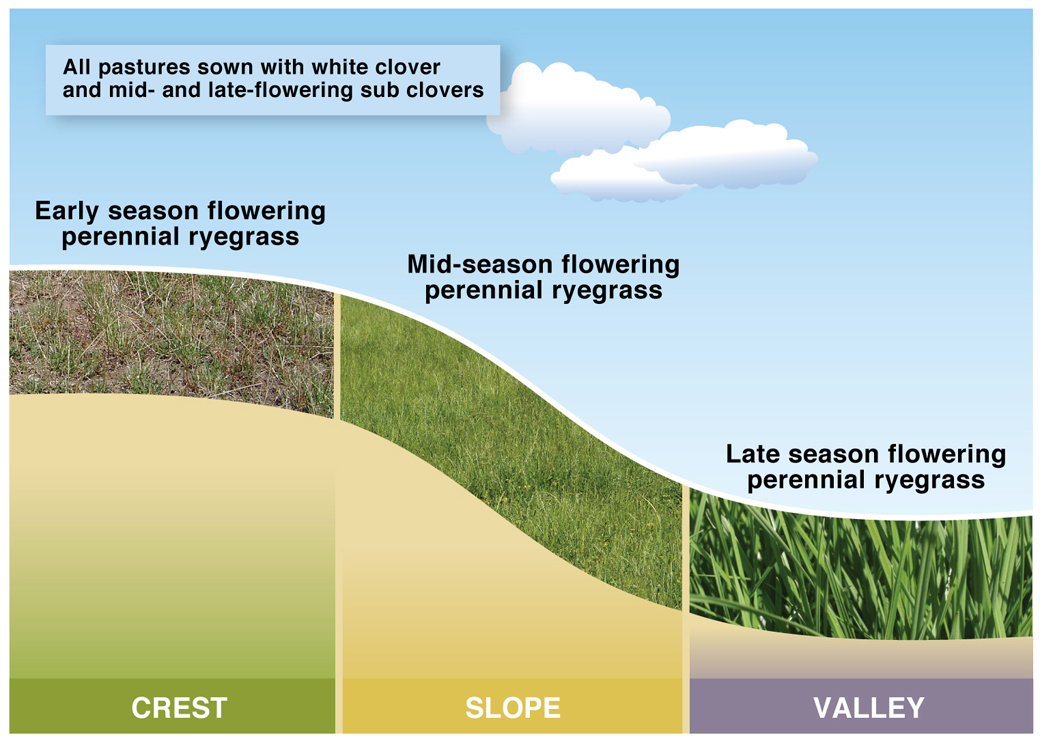
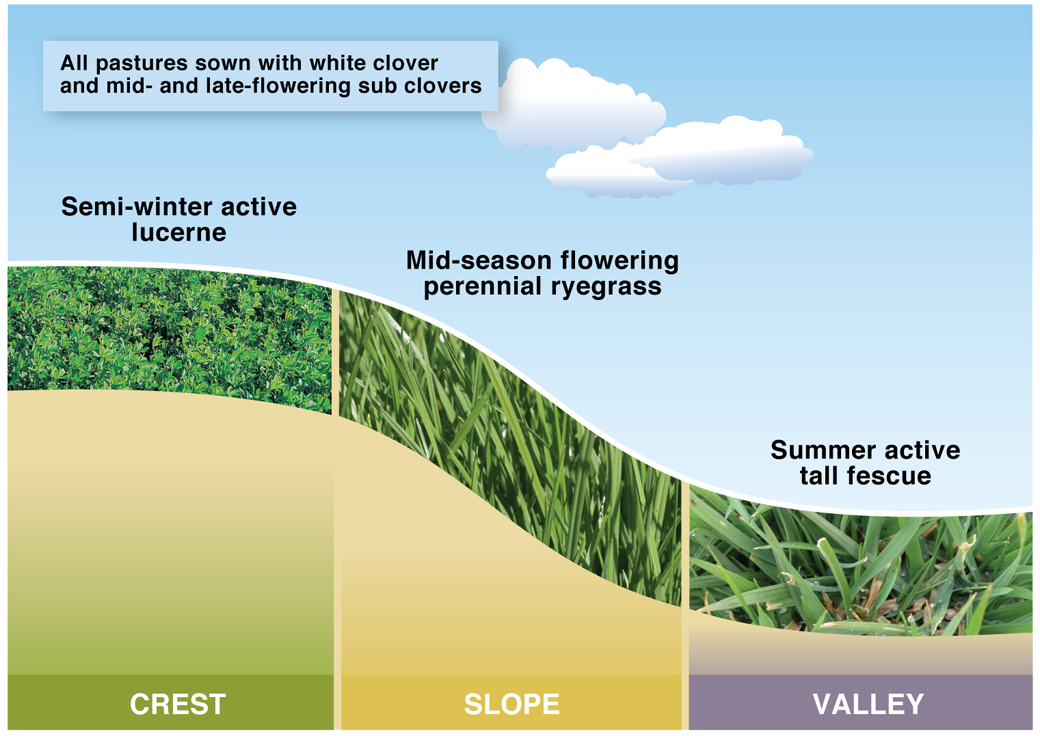
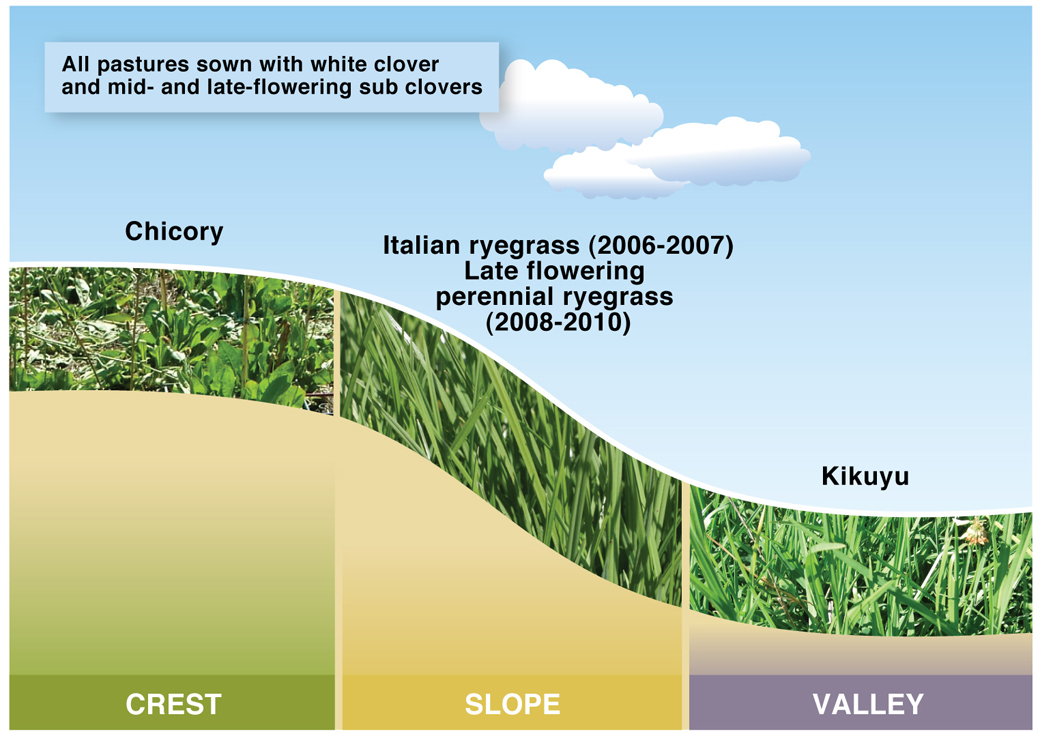
Clovers
All pastures were sown or oversown with a mix of subterranean clovers (cv. Leura and Gosse) and white clover (cv. Mink). The subterranean clover cultivars were chosen to provide a mix of flowering/maturity dates, variation in hardseedness and variation in their production and suitability to different soils and environments. Leura sub-clover is a subterranean sub-species, that is late maturing and has been shown to produce well and maintain high quality feed late into the season in this high rainfall environment and is suited to well drained loamy soils. Gosse sub-clover is a member of the yanninicum group with a mid-season flowering date, is tolerant of waterlogging and performs well on slightly acid predominately clay soils. Both these sub-clovers became the dominant legumes in the systems compared to the white clover representing approximately 20-30% of the sward during the growing season.
Establishing lucerne and chicory
Chicory and lucerne were established on the crests which consisted of a gravely loam soil with a pH of 4.8 in calcium chloride. Establishment began with spraying out the volunteer pasture in late September using a mixture glyphosate and dicamba herbicides and alpha-cypermethrin insecticide for pest control (Red Legged Earth Mite). Before sowing, agricultural lime was surface applied at 2.5 t/ha to the lucerne areas in early October 2004. The lucerne (inoculated and lime-coated seed) and chicory treatments were then direct drilled with 100 kg/ha of single superphosphate (SSP) (8.8% P and 11.0% S) using a Connor-Shea Baker-boot tine drill in late October 2004. Lucerne was sown at a rate of 9 kg/ha and the chicory was sown at 4 kg/ha. Further information on pasture establishment of the Proof Site is available in the pasture establishment actions table.
Right soil management
At the Hamilton EverGraze site, soils were managed to maintain an Olsen phosphorus level of 15 mg/kg. Soil acidity was also addressed on the crests with agricultural lime. Full details of soil treatment applications and pasture quality results at Hamilton are provided.
Best practice soil phosphorus use was based on outcomes from the Hamilton Long Term Phosphorus Experiment (LTPE) which demonstrated that maintaining good soil fertility (particularly phosphorus) is fundamental to maximising pasture production and stocking rates, maintaining pasture composition and achieving higher pasture quality for longer. In the Hamilton LTPE, stocking rates, pasture growth and pasture composition varied with different rates of soil fertility.
Information on making decisions on phosphorus use for your own farm can be found in the MLA Phosphorus Tool.
Right grazing management
Best practice grazing management for the systems was based on outcomes from Hamilton and Broadford Grazing Experiments, which demonstrated that rotational grazing was needed to maximise persistence, production and utilisation of perennial pastures. Each pasture system at Hamilton was divided into six paddocks of around half a a hectare – two on each of the crest, slope and valley floor. Rotations were predominately based on allowing the perennial ryegrass and tall fescue to re-grow three leaves prior to grazing, resulting in rotations of 14-28 days in spring, 28-42 days in summer/autumn and 42-56 days in winter.
To avoid erosion risk and maintain pasture persistence, EverGraze ground cover and feed on offer (FOO) thresholds were applied – livestock were removed from pastures and containment fed when ground cover dropped below 70% or FOO reached 800kg DM/ha. The EverGraze FOO guide for lucerne and chicory provides visual indicators for estimating FOO of these species.


Optimising enterprise and livestock management
A key element of the EverGraze principles recognises that to achieve profit and risk objectives, investing in improved perennial pastures needs to be combined with highly productive livestock and optimum tactical management.
CentrePlus and Toland Merino ewes were joined to terminal sires. The ewes were put on the pasture in February 2006 and lambed down as either single or twin bearing ewes in 2006 and 2007. Merino and Coopworth ewes (joined to terminal sires) were subsequently stocked on the site from May 2008 and they lambed in September 2008 and August 2009 as flocks containing scanned single, twin and triplet bearing ewes.
A steer/heifer back-grounding system was also run, with the animals stocked in autumn 2006, 2007 and 2008, and sold the following December or January.
A cow-calf system grazed from January 2009, with Angus- and Charolais-cross cows mated to Angus bulls for a September calving.
For more details on the livestock systems, see What was done – Hamilton systems experiment.


What was found
Lucerne persistence up to eight years
The site results provided evidence of lucerne persisting well for six years (2005-2010) following a spring sowing, lime application and rotational grazing on a well-drained soil (Figure 4). Further data (post-experiment) collected in the eighth year after sowing is showing some evidence that the lucerne is beginning to decline. The chicory pasture system was not as stable, and did not persist beyond three years. It does however offer a summer active alternative to lucerne for soils with higher acidity and aluminium.
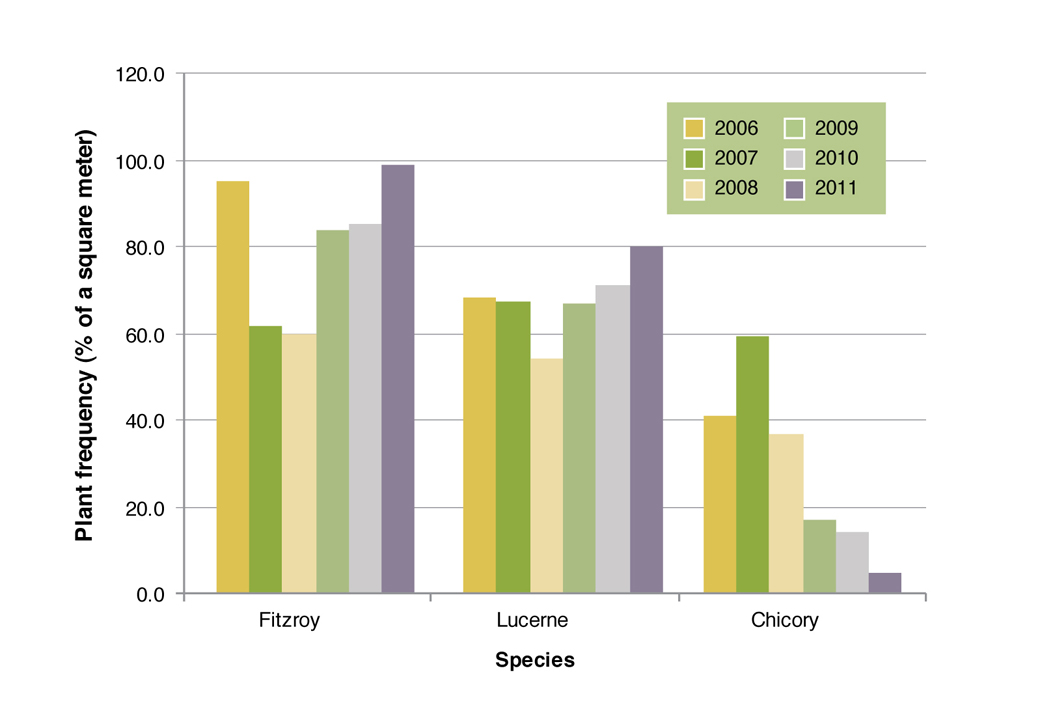


Quality summer/autumn feed
The quality of lucerne and chicory (see Table 1) is much higher than for dry perennial grass residues over summer and autumn, where digestibility commonly falls from 60% in December to 40% in March/April. Quality of both these species is dependent on summer rainfall and when the pasture was last grazed.
Lucerne responded well to summer (Jan-Mar) rainfall, with growth rates up to 34kg DM/ha/day and averaging 18kg DM/ha/day compared to early-flowing perennial ryegrass on the same part of the landscape having rates of less than 2 kg DM/ha/day over the same period.
Table 1. Summer/autumn production and quality of summer active perennials at Hamilton
| Species | Lucerne | Chicory | ||
| Pasture Growth Kg/ha/day | Digestibility (%) | Pasture Growth Kg/ha/day | Digestibility (%) | |
| Summer * | 16-34 (18) | 60 – 80% | 6 – 32 (12) | 60 – 75% |
| Autumn** | 12-25 (23) | 70 – 75% | 5- 31 (18) | 65 – 80% |
Figures in brackets are the average growth rates for the season.
* Summer includes Jan, Feb and March
**Autumn includes April, May

Caption: Lucerne (right) and perennial ryegrass (left) at the Hamilton EverGraze Proof Site 25/1/2010
More even feed availability
Lucerne produced a similar amount of dry matter per hectare to early flowering ryegrass, at 7-15 tonnes annually (see Figure 5). However, the lucerne produced 1-3 tonnes total DM/ha over summer, which together with the summer active tall fescue in the Triple system, created a more even distribution of pasture growth. While chicory grew well over the summer period, it generally had lower total annual dry matter production levels when compared to lucerne due to lower growth in winter (see Figure 4).
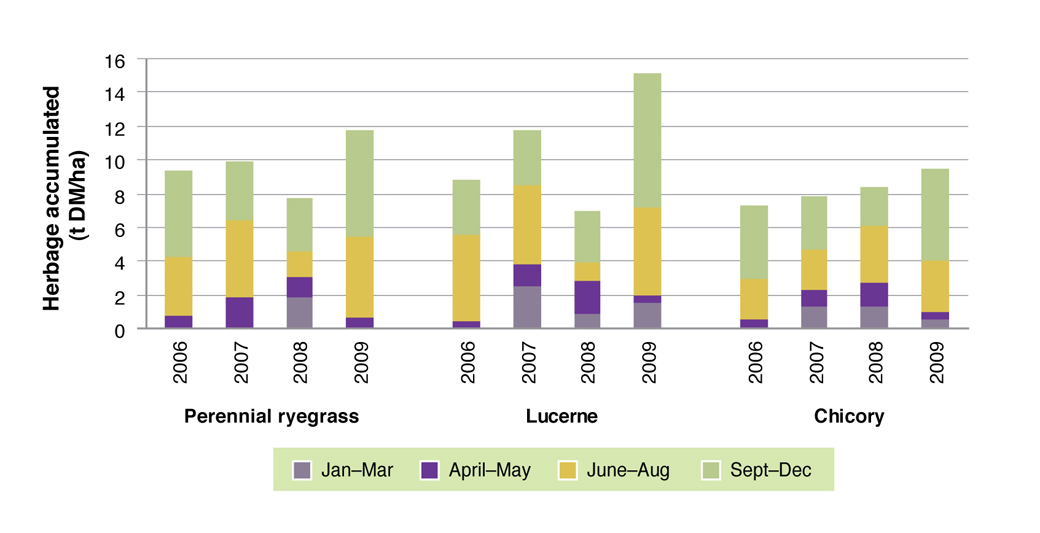
[/expand]
Summer activity at no cost to winter production
When monitored as a pasture system (i.e. including annual species such as capeweed, erodium and winter grass in the sward), the semi-winter active lucerne (dormancy rating seven) achieved very similar growth rates over winter to the early-finishing perennial ryegrass (see Figure 6), even though throughout the winter period, lucerne plants were contributing at least 50% of the total dry matter produced (see Figure 7).
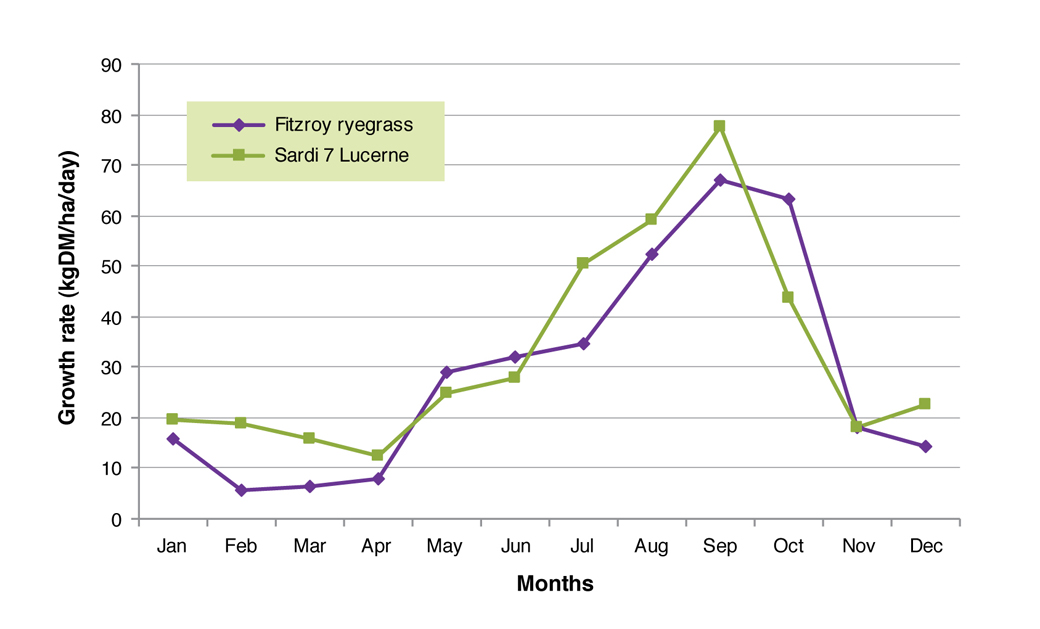
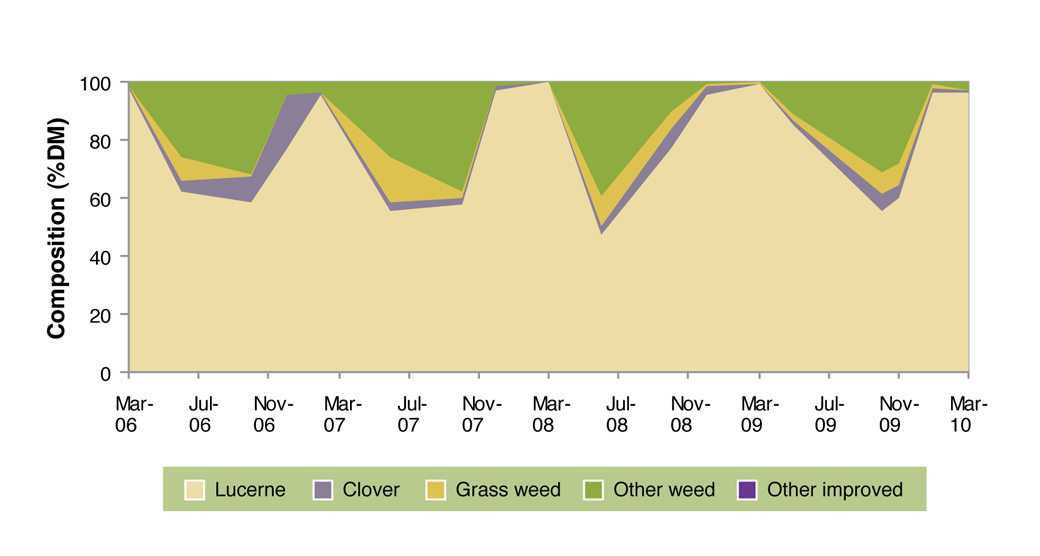
[/expand]
Lower growth with winter cleaning
Winter cleaning lucerne for annual grasses and broadleaf weeds caused growth rates during winter and early spring to drop back considerably to 5-25kg DM/ha/day. The penalty from winter cleaning needs to be considered in feed budget calculations, even when the system uses semi-winter active species.
However, periodic winter cleaning may be beneficial for improved persistence and purity of the lucerne stand in spring, which may be important for weed control over time and particularly if the paddock is being cut for hay.
Lucerne reduced salinity risk
Established lucerne rooted to a depth of three to four metres drawing water from five metres, fully controlled leakage below the root zone. This ability to draw water at depth creates a dry soil buffer which means that even in the wettest of years there will be no water escape past the roots, reducing the risk of dryland or river salinity. In the top 1.25m of the soil profile on the crests there was little difference in soil moisture but at depth of three metres the lucerne and chicory were drier than the perennial ryegrass (see Figure 8). Chicory controlled leakage until, through lack of plant persistence after three years, water use declined.
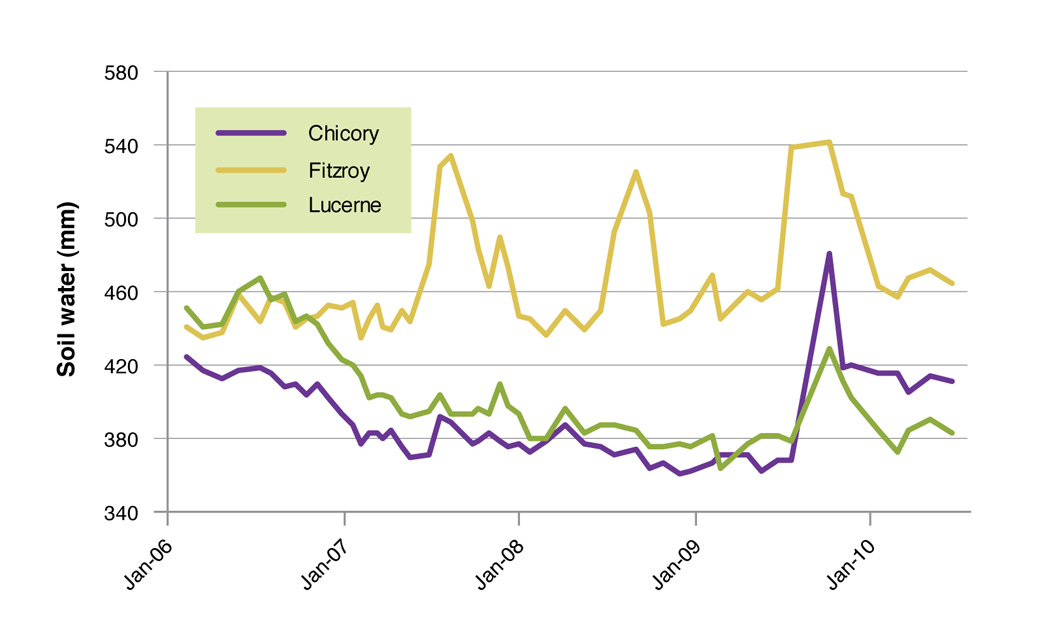
[/expand]
Benefits to the Wannon catchment
Catchment and stream flow modelling has shown that use of lucerne can control recharge and if sown to suitable land classes. However as the area of this suitable land type is limited and varies across catchments, the impact will be much less than what can be achieved on a local basis.
While lucerne is very good for reducing dryland salinity risk, it can also reduce stream flow if planted over a wide enough area and impact on the filling of farm dams. Care should be taken in the planting of lucerne above farm dams in the landscape, where the lucerne will affect the seasonal water catchment and filling of the dam.
For more information on the potential recharge, farm dam and stream flow impact of EverGraze systems on the Wannon Catchment, see EverGraze systems can reduce salinity risk in the Wannon catchment.
Crunching the numbers
Hamilton economic analysis
Economic analysis of the site production was combined with long-term modelling to understand the benefit of summer active perennials to farm profitability and risk. The focus of the analysis was on the Triple Pasture System (including lucerne) compared to the Perennial Ryegrass System. Findings were as follows:
Lower costs in drought years
The average gross margin for the Triple Pasture System (including lucerne) was similar to the Perennial Ryegrass System across all four years, except in 2006-2007 – a drought year with a short spring (see Figure 9). That year, the Triple System had a higher gross margin than did the Perennial Ryegrass System, primarily due to the lucerne saving $20/head in supplementary feed costs, just from the additional summer and autumn growth. This equates to nearly $300/ha or close to the cost of establishment.
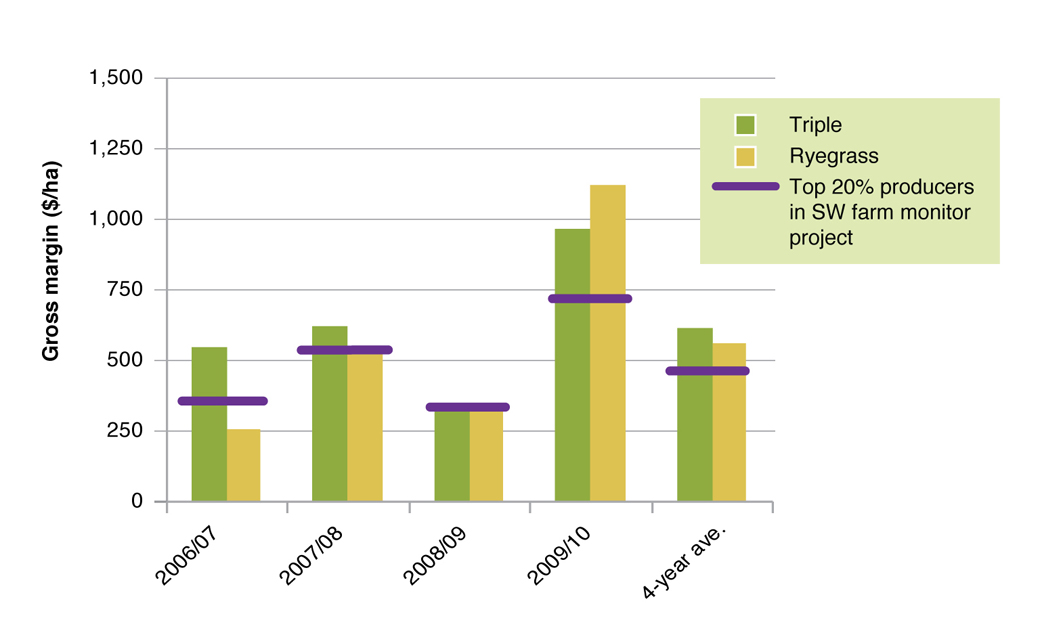


Lower seasonal risk in the long term
The site results were consistent with long-term GrassGro modeling for the Proof Site which showed that, for the sheep systems, while there was little difference in average gross margins, the variability in the Triple System was lower than the Perennial Ryegrass System.
Further modelling conducted for a farm case study in south-west Victoria showed that, in a cattle grazing system, sowing 25% of the farm to lucerne also reduced exposure to seasonal risk, compared to a farm maintained with 100% perennial ryegrass and subterranean clover. Consistent with the Proof Site results, the lower variability was due to lower supplementary feeding costs in dry years. In the worst 10% of seasons, having lucerne in the system resulted in higher gross margins of $361/ha compared to $290/ha in the Perennial Ryegrass System, a $71/ha difference (see Table 2).
Table 2. Average and range of gross margins over 40 years in a cattle grazing system under two different pasture systems.
| Perennial ryegrass pasture | Perennial ryegrass pasture + 25% of farm sown to lucerne | |
| Average Gross Margin($/ha) | $453 | $523 |
| Gross Margin Variability ($/ha) | $290- $610 | $361 – $632 |
More opportunity to finish lambs and flush ewes
Long-term modelling (39 years) using GrassGro, also indicated that the addition of lucerne (in the Triple System) increased the number of years when lambs could be carried over to reach higher sale weights, and could still have adequate green feed to flush ewes. Key results were as follows:
- For both the Triple and Perennial Ryegrass systems, in years when the amount of summer green pasture dropped below 500 kg DM/ha, it was more economic to sell the lambs when their growth rates declined to minimal levels.
- On the Perennial Ryegrass System, there would be an opportunity to hold onto lambs to sell at the end of January in 30% of years, but little opportunity to keep them into February.
- In the Triple system, there would be an opportunity to graze lambs on lucerne until the end of January in 60% of years and until the end of February in 30% years.
- For both pasture systems, the ability to keep lambs on for longer and attain heavier sale weights in a wet summer with green feed increased the gross margin by $190/ha (end Jan) to $284/ha (end March) compared to the normal selling time of mid-December.
The ability to capitalise on good years by finishing lambs on lucerne was also demonstrated at Wagga Wagga EverGraze research site, where in a wet year (2010), gross margins were increased by almost $200/ha on a system with 40% lucerne compared to a system with 20% lucerne. The Wagga site also demonstrated further benefits of using lucerne for increasing the number of lambs born by increasing ovulation rate.
Putting the research into practice
How much summer active pasture is needed?
The EverGraze Triple pasture system was designed with one third of the system being sown to lucerne. The proportion of lucerne in the system will depend on how it is intended to be used (e.g. lamb finishing) and the soils on the farm suitable for summer actives. The Wagga Wagga Proof Site tested and modelled different proportions of lucerne in the system.
Which stock gets the green feed?
When green feed is available in the summer/autumn period, a decision needs to be made as to which stock are best allocated to graze. Options may include growing out weaners (sheep or cattle), finishing lambs, increasing or maintaining the condition of ewes prior to joining, or flushing ewes for a short period at joining to increase twinning rates. The question is which option will have the greatest impact on profitability on your farm? You need to consider savings on supplementary feed, extra income from the additional lamb or beef, the amount of lucerne available and any differences in labour costs.
Tactical decisions for the use of lucerne are discussed more on the Wagga Wagga More lambs from flushing on green feed page. EverGraze has also developed a number of tools to help with these tactical decisions.
- The FOO guide for chicory and lucerne will help to estimate the amount of pasture available.
- The EverGraze Feedbase Planning and Budgeting Tools will help to budget for how long the paddock will last, or if planting lucerne, how much lucerne will be needed to do a particular job.
- The EverGraze Green Pasture Allocation Tool lets producers compare the economics of using green feed in summer for different classes of livestock.
Cultivar selection is important
SARDI 7 lucerne was chosen for the Hamilton experiment as, it was more winter active than previous cultivars but still offered strong summer activity and persistence. Lucerne cultivars vary significantly in their winter dormancy rating and grazing tolerance. Selections of cultivar dormancy should consider the growing environment and production and persistence requirements for the lucerne. Generally, lucerne cultivars that are more winter dormant are more productive in summer and persist for longer while more winter active cultivars have higher winter growth and are less persistent. Cultivars bred for improved grazing tolerance should be used particularly where rotational grazing is not likely to be tightly controlled.
Lucerne limits and management challenges
Lucerne has several characteristics that restrict where it can be grown and how it needs to be managed:
Soil limitations
Lucerne does not tolerate waterlogged soils or soils with a low pH (<4.8 in CaCl) or high aluminium in the sub soil (exchangeable aluminium exceeding 100 mg/kg in KCl or 5mg/kg in CaCl). Incorporating lime to depth is not feasible to correct soil pH or aluminium levels.
Grazing management
To optimise production, lucerne requires rotational grazing with approximately six week rests between each grazing. However, the new grazing-tolerant cultivars are promoted as being more forgiving under a looser rotation.
Animal health
Livestock should be observed closely and managed in the transition to and from lucerne pastures to enable quick actions in the case of adverse reactions.
Animal health challenges on lucerne include red-gut and pulpy kidney in sheep and bloat in cattle. For grazing with sheep it is recommended that booster vaccinations of 5 in 1 are given every three months to maintain protection against pulpy kidney. Bloat capsules need to be administered when grazing cattle on lucerne in most scenarios.
If the lucerne is lush it is also important to have access to roughage to provide some fibre and reduce the risk of health issues and possible scouring. This is particularly important for cattle which require a higher level of fibre in their diet.
Further information on managing lucerne
For further information about incorporating lucerne into pasture systems, see the EverGraze Action – Growing and Using Lucerne.
Summer active alternatives
There are also an increasing number of perennial and annual pastures options with summer activity and/or extended growing season. Examples include plantain, Arrow leaf clover, Sulla and Brassica crops. Depending on your farm environment and pasture improvement system the use of annual forages (Brassicas) as break crops over summer and autumn may also provide a cost effective way of providing higher quality feed during summer and autumn.
OnFarm examples
Lucerne is becoming widely adopted in the southwest and the success stories are well documented in EverGraze Supporting Sites and case studies. Examples are as follows:
Perennials turn summer rain into valuable feed, Shane Arnold, “Mokanger”, Cavendish
“Introducing summer active perennial pastures has significantly reduced supplementary feed costs for my Merino weaners, and has also meant we can lamb later because we have high quality feed to wean onto.”
Summer-active perennials provide flexibility – Craig and Woody Oliver, Dunkeld
Craig and Woody Oliver integrated plantain, chicory and summer active tall fescue into their farm system as part of an EverGraze Supporting Site in Dunkeld. “We think it is important to manage our property to improve profitability and labour efficiency whilst simultaneously improving the health and diversity of the farm ecosystem. Sowing summer active perennials has achieved both these aims by increasing stocking rate and reducing the need for supplementary feeding over the summer to autumn period.”
Lucerne leads to ‘more legs on the ground’ – Chris Shannon, Bookham
In 2009, Chris grazed his ewes on lucerne during joining to achieve a flushing effect. “Based on the 2009 scanning results approximately 30% more lambs, from increased twinning rates, were produced from the ewes flushed on the lucerne pasture compared to the control mob on the native pasture. Using the $67.00 we got last year for lambs off mothers – that is an extra $2010.00 per 100 ewes.”
Perennials provide perfect match for livestock – Peter Hayes, Hamilton
“Lucerne is the key to the productivity within our lamb enterprise. It provides critical summer feed for weaners from November and also extends the season at both ends to support ewe and wether production. This year lucerne has been an absolute powerhouse due to summer rain. We lambed down ewes, grazed weaners and during late autumn we grazed wethers off-shears”.
Mooney’s Gap EverGraze Supporting Site – Rod and Bernadette Vearing, Ararat
At the Mooney’s Gap Supporting Site, Rod and Bernadette Vearing established lucerne and phalaris in separate paddocks on their farm and, during the three years the experiment was in place, the Vearing’s observed significant stocking rate increases from both pastures in comparison to an unimproved control. They were also able to take advantage of a good season by locking in a price for their lambs and taking them to finishing weights on their lucerne. An EverGraze Financial Case Study covers the Vearing’s story together with experiences from other farmers in the Perennial Pasture Systems group.
What it all means
The Hamilton EverGraze site, combined with case studies and modelling, has clearly demonstrated that lucerne, when planted in the right part of the landscape, is an effective component of grazing systems for managing risk and reducing recharge and risk of dryland salinity in southwest Victoria. The results confirmed the ability for lucerne to persist, extend the growing season, reduce the requirement for supplementary feeding in summer/autumn, add flexibility to livestock management, while reducing the risk of dryland salinity.
The benefits of lucerne are more apparent when it can be grown on a significant proportion of the farm, and the grazing system focuses on carrying over young growing stock or breeding females. There are also several management practices which need to be considered to maintain the persistence of lucerne and livestock health while grazing it. Therefore, the decision to sow lucerne should be considered alongside the existing livestock, pasture and management style of the farm.
Acknowledgements
EverGraze is a Future Farm Industries CRC research and delivery partnership. The Hamilton EverGraze Proof Site team was led by Dr Ralph Behrendt and consisted of scientists and technical staff within Agriculture Victoria. An enthusiastic Regional Advisory Group consisting of farmers, consultants, extension officers and CMA staff provided significant input into the direction, management practices and interpretation of outcomes from the experiment and modelling to make them relevant to farmers.
Further Information
- Hamilton EverGraze Research – Right Plant, Right Place, Right Purpose, Right Management
- Wagga Wagga EverGraze Research: More lambs from flushing on green feed
- EverGraze Action – Growing and Using lucerne
- Hamilton EverGraze Research: EverGraze systems can reduce salinity in the Wannon catchment
- Wagga Wagga EverGraze: Lucerne provides opportunity to capitalise on good years
- Morant A, Saul G, Hamilton EverFarm – Making strategic decisions on farm
- Warn, L. (2011) Hamilton EverGraze Proof Site: Report on the impact of changing management regimes on profitability. August 2011, Mackinnon, University of Melbourne
- Clarke, S. et al. (2013) Can summer-active perennial species improve pasture nutritive value and sward stability?
- Ward, G. et al. (2013) Summer-active perennials in pasture systems improve seasonal pasture distribution without compromising winter-spring production
- EverGraze Case Study – Summer-active perennials provide flexibility – Craig and Woody Oliver, Dunkeld
- EverGraze Case Study – Lucerne leads to ‘more legs on the ground’ – Chris Shannon, Bookham
- EverGraze Case Study – Perennials provide perfect match for livestock – Peter Hayes, Hamilton
- EverGraze Supporting Site – Lucerne and phalaris systems at Mooneys Gap – Rod and Bernadette Vearing, Ararat
- EverGraze Case Study – Perennials turn summer rain into valuable feed – Shane Arnold, Cavendish
- Video: Peter Hayes case study

